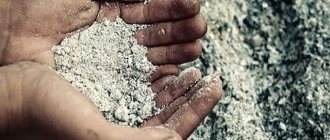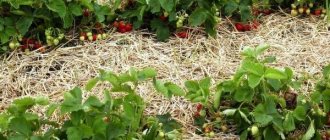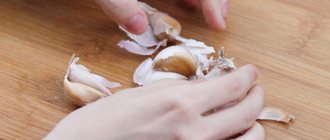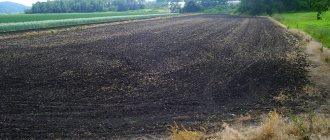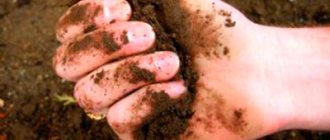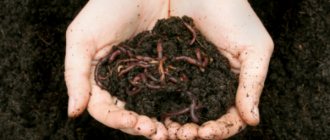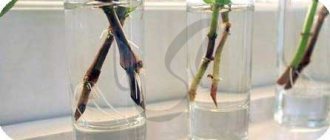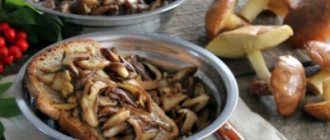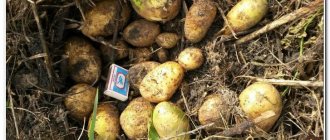Home > k) Organic farming. > Aerated compost tea. Or how to prepare a high-quality EO preparation yourself
Published January 13, 2014 Author: Valery Medvedev
The topic of aerated compost tea (ACT) has been studied in the West for more than 10 years and has even been given a scientific basis for this topic. Our experienced gardener Gennady Raspopov described this direction well.
I want to convey this topic in simple language, because... If we consider the entire AKH comb from a scientific point of view, then you can get confused in the terms and not understand the essence.
And the essence is very simple. Proper ACH (Aerated Compost Tea) is a solution very rich in effective microorganisms, which is used as a growth stimulator and plant protection from diseases.
The fact is that all EO preparations such as “Shine” or “Baikal” contain a limited number of varieties of effective microorganisms that can generally exist without access to oxygen. In nature, the world of microorganisms is a thousand times richer, where there are not only bacteria and fungi, but also a huge world of protozoa (amoeba, ciliates, nematodes, etc.)
And if you prepare ACC yourself, its composition will be many times richer, and therefore more effective, than any purchased EM drugs.
What is aerated compost tea
Compost tea prepared through the aeration process is a natural organic fertilizer that increases soil productivity. Only on fertile, healthy soil with well-developed microflora can large yields be obtained. The main function of the ACC is to saturate the soil with anaerobic bacteria, thereby creating optimal conditions for the production of new batches of beneficial microorganisms.
The mechanism of action of such tea is similar to EM preparations that have earned a good reputation among gardeners (such as Baikal-M), but unlike them, AKCh has a long-term effect. EM preparations are applied at certain intervals, since plants need constant stimulation, and the content of microorganisms in them is limited. In the case of compost tea, the composition is many times richer; in addition, new chains of interaction between bacteria, fungi, and other protozoa are created in the microflora, contributing to the improvement and health of the soil.
How to Make Compost Tea Without a Pump or Compressor
If you cannot get a compressor or pump, you can prepare the drug without saturating it with air. There will be many times fewer beneficial microorganisms in such a preparation, but such a product also has its own beneficial properties.
You need to take a large ten-liter bucket and fill it thirty percent with mature compost, and then fill it to the top with any water other than tap water. After thorough stirring, the solution is left for a week. It is very important that the solution is mixed several times during the day (every day). In a week the drug will be ready. Before using it, all you have to do is strain it through a sieve, cloth or nylon stocking.
You can use another method of preparing compost tea with a little air saturation. You don't need a compressor or pump for this. You will need to take a large bucket and place a smaller container in it with holes in the bottom. The solution must be poured into a smaller container and left until the liquid completely seeps into another container. After this, the compost tea is thoroughly mixed and again poured into a smaller container. This procedure can be repeated several times and the liquid will be saturated with air.
Specifics of preparing aerated compost tea
The basis of natural fertilizer is compost, but well-rotted, ripened mass is suitable. The best tea is made from old raw materials taken from a compost pit or heap overgrown with weeds and weeds. In such “storages” entire systems of microorganisms have been formed, but it is necessary to transfer them into a useful solution and increase their quantity.
The next component is water, preferably spring water and in no case chlorinated. Even settled water is not suitable for preparing the elixir. It is recommended to use well, river, pond, or lake water, but not from the tap.
A compressor is used for aeration. Aquarium devices are suitable, but if you plan to prepare a large amount of solution, purchase a special kit.
The next component of tea is molasses, black molasses, which consists of 60% carbohydrates. It is obtained as a by-product of sugar production and is often used by fishermen in their feeding. Molasses is a nutrient medium for microorganisms; it can be replaced with jam or malt extract.
To obtain tea, it is necessary not only to mix the components, but also to include aeration. Only in an aquatic environment saturated with oxygen do aerobes, useful and necessary for plants, develop, and anaerobes go into a dormant state or die.
On a note! The finished infusion is used within 3-4 hours after preparation. On hot days, the solution is sold within 1-2 hours.
To water plants, two liters of useful elixir are consumed per one hundred square meters of area.
Ingredients and equipment
To prepare a compost solution saturated with microorganisms, you only need four components:
- High-quality humus (compost). This ingredient can be taken from old compost heaps that have long been overgrown with weeds; this is where the highest diversity of beneficial microorganisms necessary to stimulate plant growth is observed.
- Molasses, which acts as a nutrient medium for the life and development of microorganisms.
- Water. It is important here that the water is as clean as possible. If you can use spring water, use it; river and well water will also work. Do not use chlorinated water to prepare aerated water - you will waste your time.
- Compressor. You can use a regular aquarium compressor, but if possible, it is better to purchase a special kit for preparing ACH.
Required condition: use distilled or rain water. If using tap water, place air stones in it to remove chlorine.
Instructions for preparing AKCH
All of the listed components are prepared in advance, including a three-liter glass jar. Two liters of clean water are poured into a container, a tablespoon of molasses is added, and mixed.
After this, load the compressor, turn it on, and only after 2-3 minutes add a glass of mature compost.
Tea preparation time is 1-1.5 days (air temperature +20ºC...+22 ºC), at higher temperatures (+30ºC) AKCH is prepared faster, in 18-20 hours.
Readiness is recognized by a smell reminiscent of earth, with notes of bread or leaven, but in no case rotten. If the slightest signs of putrefactive processes appear, the infusion cannot be used. The reason is low-quality components, violation of cooking technology. This smell indicates the presence of anaerobic, putrefactive microorganisms in the tea that disrupt the normal microflora of the soil.
The solution is not tasted; you also need to work very carefully with the composition, trying not to inhale the vapors of the infusion.
Application of compost tea with aeration
This organic preparation allows you to increase the germination of seeds and speed up the appearance of the first shoots if you place them in a bubbling liquid in a small fabric bag. And they will also be completely disinfected.
This natural remedy is used for watering the soil before planting seeds, as well as for watering seedlings that have been picked. The drug promotes better survival of young plants in new conditions.
Unfiltered compost tea can be used to water the mulch layer or soil in spring beds. This universal liquid is able to “warm up” the soil and add at least two more degrees of heat to it. This will allow you to plant some vegetable crops 10-15 days ahead of schedule.
Spraying filtered and diluted compost tea with water stimulates growth and accelerates fruiting of fruit and vegetable crops. Such a shower - fertilizer is best carried out using a small plastic bottle and a sprayer, and you need to add a little sunflower oil to the solution (about 0.5 teaspoon per 10 liters of the drug).
Before watering, the finished product is diluted with water in a ratio of 1 to 5, and for spraying - 1 to 10. These procedures can be repeated at least 3 times during the entire warm season, and a maximum of 2 times a month.
Compost-based tea is an absolutely independent preparation and cannot replace such useful measures as the use of green manure or mulch, or the construction of warm beds. The soil cannot be saturated and get by with only one organic preparation. The more organic matter, the better the soil structure and the condition of the crops grown.
Application for tomatoes
Options for using aerated compost tea for tomatoes:
- Disinfection and stimulation of seeds before sowing. To do this, tomato seeds in a bag are dipped in a bubbling tea solution for 10-12 hours.
- Watering the soil before planting seeds, seedlings (one watering is enough), as well as tomatoes after diving and planting in greenhouses or ridges. The composition is first diluted with clean (without bleach) water 1:5. For irrigation, ACH is not filtered.
- Spraying tomatoes (at any stage). The composition is diluted with water 1:10, filtered, and poured into a spray bottle. To improve adhesion, add 1 ml of any vegetable oil. Spray the tomatoes on the leaves. If it rains after treatment, the treatment procedure is repeated for tomatoes in the garden.
- Tilling the soil in spring when preparing beds for tomatoes. Per hundred square meters - two liters of solution.
Advantages
AKCh amazes with its properties, among other advantages the following should be mentioned
- It is a natural product that increases soil productivity.
- The use of this additive eliminates the need to use chemical fertilizers.
- Application in soil reduces toxicity if chemical treatment has been carried out in advance.
- The ability to retain water is increased, resulting in less moisture loss.
- AKCh application In addition to adding fertilizers to the soil, they also help control pests and prevent the development of pathogenic bacteria, mold and fungi.
Advantages and disadvantages of tea
When using aerated compost tea, the ripening time of fruits is accelerated, more tomatoes are harvested, and their taste improves. ACC also contributes to:
- activation of beneficial microorganisms in the soil;
- improving soil structure;
- the diversity of groups of bacteria and fungi that form the soil rhizosphere;
- soil improvement;
- cleansing the soil of dangerous toxins that have formed and accumulated over the past years;
- improving the condition of plants, strengthening tomatoes;
- protecting tomatoes from harmful infections, increasing immunity.
Biomass useful for plants is actively formed in the soil, humins accumulate, increasing the fertility of the soil. The use of aerated tea on depleted and depleted soils is especially important. The correct use of organic fertilizer helps to increase and improve the biological components of the soil, obtaining abundant harvests and environmentally friendly tomatoes.
What is ACH
Gennady Raspopov
Aerated compost tea is a liquid rich in beneficial microorganisms that stimulates plant growth and also protects against all kinds of diseases.
Western countries have been interested in this product for more than ten years. In our country, due to the consequences of the collapse of the USSR, science, especially related to the agricultural sector, has lagged far behind. And only recently has there begun to be an interest among gardeners in using ACH on their plots.
In our country, Gennady Raspopov, a famous gardener, approached the issue of the essence of AKCH and its preparation most seriously.
Tips for making good compost tea
Attention to quality
Compost tea is most effective when using quality ingredients. Always use properly aged compost when making fertilizer.
Materials that are too old will not contain many nutrients. And compost that has not had time to decompose contains pathogens that can harm plants.
Aeration
By aerating the compost tea, there will be much more beneficial bacteria in the mixture. The easiest way to aerate compost tea is to stir it occasionally while it steeps.
Aeration of compost tea can also be done using a regular or aquarium pump.
Adding Powerful Ingredients
You can increase the effectiveness of compost tea by adding things like fish emulsion, powdered seaweed, coffee grounds and worms. This helps increase the nutrient factor of the compost and stimulates plant growth.
Take your time
Making compost tea is quite simple, but it takes a lot of time. The brewing process can take anywhere from 24 hours to a week, depending on how potent you want the fertilizer to be.
Many compost tea makers recommend steeping it for at least 48 hours. The longer the tea is brewed, the stronger it will be.
Compost tea for marijuana. What do you need to make your own compost tea?
To make the simplest aerated compost tea, you will need an aerator, water, compost, and a microbial nutrient supplement.
An aerator consists of an air pump, a tube and a nozzle for the formation of small bubbles.
The water should be left in an open container for several hours (preferably a day) so that all the chlorine evaporates. Chlorine is added to water precisely to kill microorganisms. It is clear that in our case it is completely unnecessary. By the way, ready-made compost tea can only be diluted with settled water. For the same reason.
Compost is what determines the quality of the “tea”. The more types of aerobic organisms it contains, the richer the compost tea will be. It is clear that in real conditions, few people have the opportunity to test compost in the laboratory (to know for sure what bacteria and fungi it contains). So take what you have and hope for the best. Also, don’t forget about vermicompost, that is, compost processed by earthworms. The waste products of earthworms contain a huge number of microorganisms that are beneficial for hemp.
To feed the microbes, you can add regular sugar or fermented jam to the solution, however, if you have the opportunity, use molasses (molasses), brown algae (kelp), fish by-products or humic acids. Additionally, many cannabis growers are familiar with commercial supplements that provide sugar for the buds during the final weeks of flowering. These preparations are also suitable for feeding bacteria in compost tea.
Under conditions of constant aeration of the solution (saturation with air), bacteria actively multiply and reach a peak in numbers and diversity after 24-48 hours. It is recommended to use ready-made compost tea within 4-6 hours after preparation - before microbes begin to compete with each other for oxygen and nutrients. You can also extend the shelf life - to do this, you need to keep the jar of compost tea open and periodically stir vigorously.
ACC for marijuana. What do you need to make your own compost tea?
To make the simplest aerated compost tea, you will need an aerator, water, compost, and a microbial nutrient supplement.
An aerator consists of an air pump, a tube and a nozzle for the formation of small bubbles.
The water should be left in an open container for several hours (preferably a day) so that all the chlorine evaporates. Chlorine is added to water precisely to kill microorganisms. It is clear that in our case it is completely unnecessary. By the way, ready-made compost tea can only be diluted with settled water. For the same reason.
Compost is what determines the quality of the “tea”. The more types of aerobic organisms it contains, the richer the compost tea will be. It is clear that in real conditions, few people have the opportunity to test compost in the laboratory (to know for sure what bacteria and fungi it contains). So take what you have and hope for the best. Also, don’t forget about vermicompost, that is, compost processed by earthworms. The waste products of earthworms contain a huge number of microorganisms that are beneficial for hemp.
To feed the microbes, you can add regular sugar or fermented jam to the solution, however, if you have the opportunity, use molasses (molasses), brown algae (kelp), fish by-products or humic acids. Additionally, many cannabis growers are familiar with commercial supplements that provide sugar for the buds during the final weeks of flowering. These preparations are also suitable for feeding bacteria in compost tea.
Under conditions of constant aeration of the solution (saturation with air), bacteria actively multiply and reach a peak in numbers and diversity after 24-48 hours. It is recommended to use ready-made compost tea within 4-6 hours after preparation - before microbes begin to compete with each other for oxygen and nutrients. You can also extend the shelf life - to do this, you need to keep the jar of compost tea open and periodically stir vigorously.

